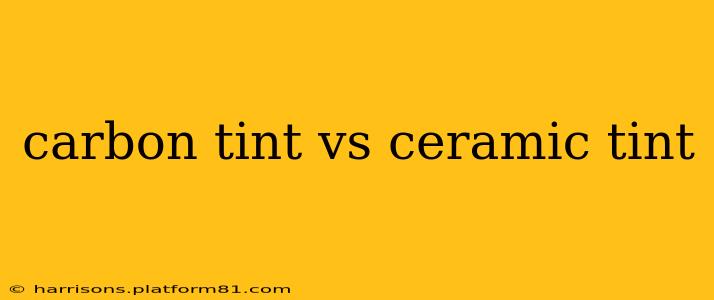Choosing the right window tint can significantly impact your driving experience and vehicle's appearance. Two popular options are carbon tint and ceramic tint, each offering distinct advantages and disadvantages. This comprehensive guide will break down the key differences, helping you decide which film best suits your needs and budget.
What is Carbon Tint?
Carbon tint, also known as carbon film, utilizes layers of carbon-based materials to block heat and UV rays. This type of tint typically offers a dark, sleek appearance, making it a popular choice for those seeking a stylish upgrade.
Advantages of Carbon Tint:
- Affordable: Generally less expensive than ceramic tint.
- Dark Appearance: Provides a deep, dark look that many drivers find attractive.
- Good Heat Rejection: Offers decent heat rejection, reducing the amount of solar heat entering your vehicle.
Disadvantages of Carbon Tint:
- Lower Heat Rejection Compared to Ceramic: While it blocks some heat, it's not as effective as ceramic tint in reducing interior temperatures.
- Potential for Signal Interference: Can interfere with radio signals, GPS, and other electronic devices, especially with darker tints.
- Less Durable: May fade or crack more easily over time compared to ceramic tint.
What is Ceramic Tint?
Ceramic tint is a premium window film composed of microscopic ceramic particles that effectively block infrared (IR) radiation, the primary source of heat from the sun. This technology provides superior heat rejection while maintaining a clearer view and minimal signal interference.
Advantages of Ceramic Tint:
- Superior Heat Rejection: Significantly reduces interior temperatures, leading to improved comfort and potentially lower fuel consumption in some instances.
- Minimal Signal Interference: Less likely to interfere with electronic signals like GPS, Bluetooth, and radio.
- UV Protection: Offers excellent protection against harmful ultraviolet (UV) rays, shielding your skin and interior from sun damage.
- Longer Lifespan: Generally more durable and resistant to fading and cracking than carbon tint.
- Clearer Visibility: Often boasts higher clarity, resulting in a less distorted view compared to carbon tint.
Disadvantages of Ceramic Tint:
- Higher Cost: Significantly more expensive than carbon tint.
- Installation Complexity: May require more specialized installation techniques due to its composition.
Carbon Tint vs. Ceramic Tint: A Detailed Comparison
| Feature | Carbon Tint | Ceramic Tint |
|---|---|---|
| Price | Lower | Higher |
| Heat Rejection | Moderate | Superior |
| UV Protection | Good | Excellent |
| Signal Interference | Potential | Minimal |
| Durability | Lower | Higher |
| Appearance | Dark, sleek | Clearer, less visible film |
| Lifespan | Shorter | Longer |
Which Tint is Right for Me?
The best window tint for you depends on your priorities and budget.
-
Choose carbon tint if: You're on a budget and prioritize a dark, stylish look. You're less concerned about maximum heat rejection and are willing to accept some potential signal interference.
-
Choose ceramic tint if: You prioritize superior heat rejection, clarity, and longevity. You're willing to invest more for a premium product that offers long-term value and better performance.
What are the different types of window tint film?
This question delves into the wider variety of window tint films available, extending beyond carbon and ceramic. While carbon and ceramic are popular, other options include dyed films (offering basic UV protection and a tinted look), metalized films (incorporating metallic layers for heat reflection, often with higher signal interference), and hybrid films (combining different technologies for a balanced approach). The best type for you will depend on the specific benefits you value most.
How much does window tint cost?
The cost of window tint varies significantly based on factors such as the type of film, vehicle size, and installer. Carbon tint generally costs less than ceramic tint, while the price for both can fluctuate depending on location and the installer's pricing structure. Expect to pay more for high-quality ceramic film and professional installation. Getting multiple quotes is advisable before committing.
How long does window tint last?
The lifespan of window tint depends largely on the type of film, the quality of installation, and exposure to environmental factors like UV radiation and extreme temperatures. Generally, ceramic tints have a longer lifespan, lasting up to 10 years or more, compared to carbon tints, which may need replacement sooner, potentially within 5 years.
By carefully considering your needs and budget, you can select the window tint that provides optimal performance and enhances your driving experience. Remember to choose a reputable installer to ensure proper application and maximize the lifespan of your chosen film.
